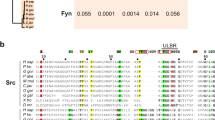Abstract
Smad proteins mediate the transforming growth factor β responses. C-terminal phosphorylation of R-Smads leads to the recruitment of Smad4 and the formation of active signaling complexes. We investigated the mechanism of phosphorylation-induced Smad complex formation with an activating pseudo-phosphorylated Smad3. Pseudo-phosphorylated Smad3 has a greater propensity to homotrimerize, and recruits Smad4 to form a heterotrimer containing two Smad3 and one Smad4. The trimeric interaction is mediated through conserved interfaces to which tumorigenic mutations map. Furthermore, a conserved Arg residue within the L3 loop, located near the C-terminal phosphorylation sites of the neighboring subunit, is essential for trimerization. We propose that the phosphorylated C-terminal residues interact with the L3 loop of the neighboring subunit to stabilize the trimer interaction.
This is a preview of subscription content, access via your institution
Access options
Subscribe to this journal
Receive 12 print issues and online access
$189.00 per year
only $15.75 per issue
Buy this article
- Purchase on Springer Link
- Instant access to full article PDF
Prices may be subject to local taxes which are calculated during checkout




Similar content being viewed by others
Accession codes
References
de Caestecker, M.P., Piek, E. & Roberts, A.B. J. Natl. Cancer Inst. 92, 1388–1402 (2000).
Blobe, G.C., Schiemann, W.P. & Lodish, H.F. New Eng. J. Med. 342, 1350–1358 (2000).
Heldin, C.H., Miyazono, K. & ten Dijke, P. Nature 390, 465–471 (1997).
Massague, J. & Wotton, D. EMBO J. 19, 1745–1754 (2000).
Liu, F., Pouponnot, C. & Massague, J. Genes Dev. 11, 3157–3167 (1997).
Shi, Y., Hata, A., Lo, R.S., Massague, J. & Pavletich, N.P. Nature 388, 87–93 (1997).
Shi, Y. et al. Cell 94, 589–594 (1998).
de Caestecker, M.P. et al. J. Biol. Chem. 272, 13690–13696 (1997).
Qin, B., Lam, S.S.W. & Lin, K. Structure 7, 1493–1503 (1999).
de Caestecker, M.P. et al. J. Biol. Chem. 275, 2115–2122 (2000).
Liu, X. et al. Proc. Natl. Acad. Sci. USA 94, 10669–10674 (1997).
Souchelnytskyi, S. et al. J. Biol. Chem. 272, 28107–28115 (1997).
Abdollah, S. et al. J. Biol. Chem. 272, 27678–27685 (1997).
Macias-Silva, M. et al. Cell 87, 1215–1224 (1996).
Kawabata, M., Inoue, H., Hanyu, A., Imamura, T. & Miyazono, K. EMBO J. 17, 4056–4065 (1998).
Wu, R.Y., Zhang, Y., Feng, X.H. & Derynck, R. Mol. Cell. Biol. 17, 2521–2528 (1997).
Zhang, Y., Feng, X.H. & Derynck, R. Nature 394, 909–913 (1998).
Yingling, J.M. et al. Mol. Cell. Biol. 17, 7019–7028 (1997).
Zawel, L. et al. Mol. Cell 1, 611–617 (1998).
Kim, R.H. et al. Genes Dev. 14, 1605–1616 (2000).
Wu, G. et al. Science 287, 92–97 (2000).
Eppert, K. et al. Cell 86, 543–552 (1996).
Sekelsky, J.J., Newfeld, S.J., Raftery, L.A., Chartoff, E.H. & Gelbart, W.M. Genetics 139, 1347–1358 (1995).
Savage, C. et al. Proc. Natl. Acad. Sci. USA 93, 790–794 (1996).
Lo, R.S., Chen, Y.G., Shi, Y., Pavletich, N.P. & Massague, J. EMBO J. 17, 996–1005 (1998).
Feng, X.H., Lin, X. & Derynck, R. EMBO J. 19, 5178–5193 (2000).
Labbe, E., Silvestri, C., Hoodless, P.A., Wrana, J.L. & Attisano, L. Mol. Cell 2, 109–120 (1998).
Tsukazaki, T., Chiang, T.A., Davison, A.F., Attisano, L. & Wrana, J.L. Cell 95, 779–791 (1998).
Otwinowski, Z. & Minor, W. Methods Enzymol. 276, 307–326 (1997).
Brunger, A.T. et al. Acta Crystallogr. D 54, 905–921 (1998).
Sack, J.S. J. Mol. Graphics 6, 244 (1988).
Jonk, L.J., Itoh, S., Heldin, C.H., ten Dijke, P. & Kruijer, W. J. Biol. Chem. 273, 21145–21152 (1998).
Correia, J.J., Chacko, B.M. & Lam, S.S, & Lin, K. Biochemistry in the press (2001).
Acknowledgements
We thank A. Roberts (NIH), M. Marinus (UMass), and K. Knight (UMass) for helpful suggestions of the manuscript, R. Derynck for the Smad4-Myc construct and the wild type GST fusion Smad3/Smad4 constructs, W. Kruijer for the SBE-Lux construct, S. Davis for technical assistance. This research is funded by the Sidney Kimmel Foundation Scholar Award and the center grant from the Diabetes and Endocrinology Research Center.
Author information
Authors and Affiliations
Corresponding author
Rights and permissions
About this article
Cite this article
Chacko, B., Qin, B., Correia, J. et al. The L3 loop and C-terminal phosphorylation jointly define Smad protein trimerization. Nat Struct Mol Biol 8, 248–253 (2001). https://doi.org/10.1038/84995
Received:
Accepted:
Issue Date:
DOI: https://doi.org/10.1038/84995
This article is cited by
-
Long noncoding RNA Smyca coactivates TGF-β/Smad and Myc pathways to drive tumor progression
Journal of Hematology & Oncology (2022)
-
RGS6 suppresses TGF-β-induced epithelial–mesenchymal transition in non-small cell lung cancers via a novel mechanism dependent on its interaction with SMAD4
Cell Death & Disease (2022)
-
SnoN Stabilizes the SMAD3/SMAD4 Protein Complex
Scientific Reports (2017)
-
Rewiring of the apoptotic TGF-β-SMAD/NFκB pathway through an oncogenic function of p27 in human papillary thyroid cancer
Oncogene (2017)
-
The changing role of TGFβ in healthy, ageing and osteoarthritic joints
Nature Reviews Rheumatology (2017)



